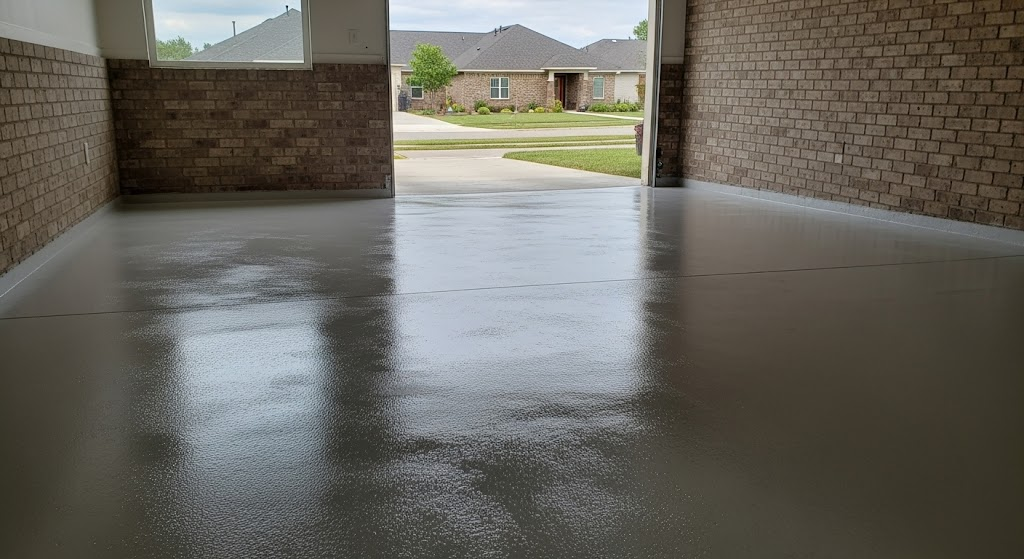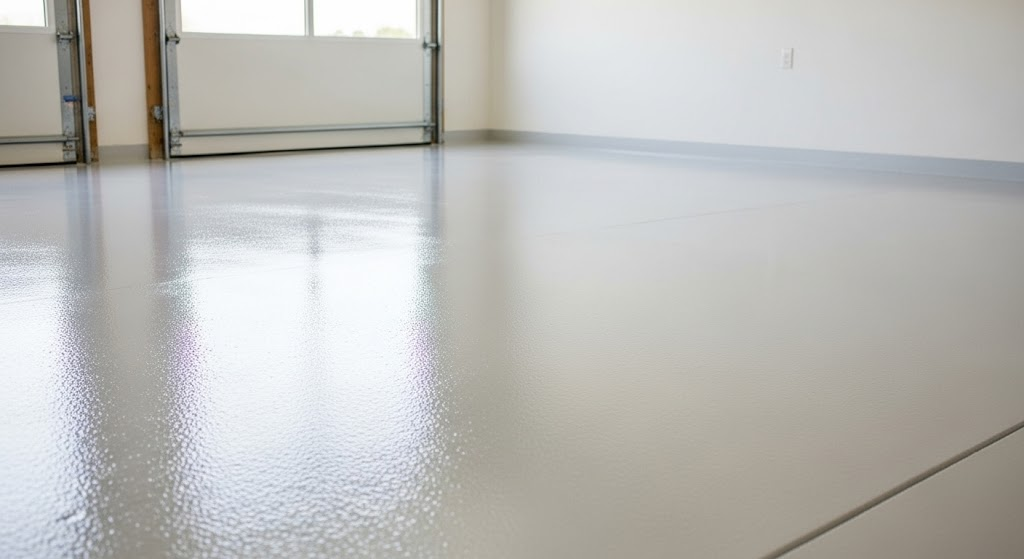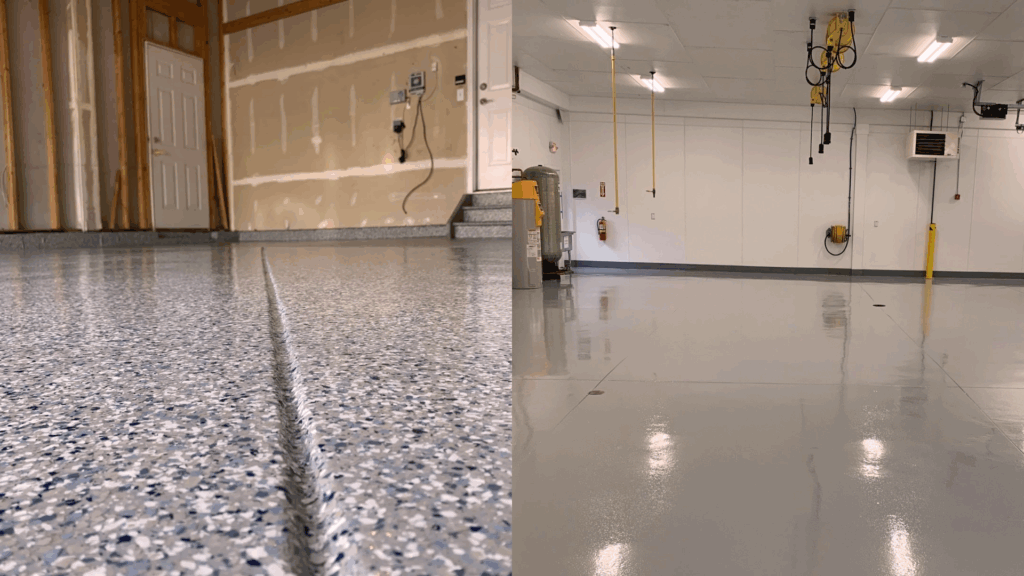Upgrading your garage floor is a great way to enhance both its look and functionality. Two of the most popular options for this upgrade are paint and epoxy coatings.
Both offer excellent protection and can significantly improve the appearance of your garage, but they come with different benefits and challenges.
Choosing the right one can feel overwhelming with all the factors to consider, from cost to durability. I’ve been through the process myself, and I know how important it is to make an informed decision.
In this guide, I’ll compare paint and epoxy coatings in key areas such as cost, durability, maintenance, and visuals.
By the end, you’ll have a clearer understanding of which option is best suited for your garage needs.
What Is Garage Floor Paint?

Garage floor paint is a protective coating designed specifically for concrete surfaces, usually made from latex or acrylic. It provides an easy and cost-effective way to enhance and protect your garage floor.
The paint is applied directly to the concrete, creating a smooth and durable layer that can resist stains, dirt, and light abrasions.
It’s a great option for homeowners who want to refresh their garage without committing to a more expensive or complex solution like epoxy. Garage floor paint dries relatively quickly, making it ideal for DIY projects.
However, while it offers a glossy, attractive finish, it doesn’t provide the same level of durability or resistance to heavy traffic and chemicals as epoxy.
Pros and Cons of Garage Floor Paint
Garage floor paint provides an affordable and straightforward solution for enhancing the appearance of your garage, but it has both advantages and limitations.
| Pros | Cons |
|---|---|
| Affordable: Less expensive than epoxy. | Less Durable: May wear and fade over time. |
| Easy Application: Simple to apply, ideal for DIY projects. | Frequent Reapplication: Needs to be reapplied more often, especially in high-traffic areas. |
| Quick Drying: Dries faster than epoxy, minimizing downtime. | Not Ideal for High Traffic: Can chip or scratch under heavy use. |
| Variety of Colors: Available in many color options. | Prone to Staining: May absorb oils or chemicals. |
| Improves Appearance: Provides a clean, polished look for the garage. | Less Resistant to Chemicals: Vulnerable to damage from harsh chemicals. |
What Is Epoxy Garage Flooring?

Epoxy garage flooring is a high-performance coating made by mixing a resin and hardener to create a strong, durable surface that bonds directly to the concrete.
This type of flooring is known for its exceptional strength, chemical resistance, and long-lasting finish, making it an ideal choice for garages that experience heavy traffic or exposure to oils, grease, and other harsh substances.
Unlike paint, epoxy creates a seamless, tough surface that resists stains, scratches, and impacts.
However, the application process requires more preparation, such as cleaning and etching the concrete, to ensure proper adhesion.
Additionally, epoxy has a longer curing time, which means the garage may be out of use for a few days after application.
Pros and Cons of Epoxy Garage Flooring
Epoxy garage flooring offers a highly durable and protective surface, but it comes with both advantages and challenges.
| Pros | Cons |
|---|---|
| Durable: Resistant to stains, scratches, and impact. | Complex Application: Requires thorough surface preparation and more application steps. |
| Chemical Resistance: Ideal for areas exposed to oils, chemicals, and grease. | Long Curing Time: Needs 24–72 hours to fully cure, limiting use. |
| Low Maintenance: Easy to clean and maintain once applied. | Costlier: Higher upfront cost compared to paint, especially for professional installation. |
| Long-Lasting: Lasts 5–10 years with proper care. | Slippery When Wet: Can be hazardous unless anti-slip additives are used. |
| Aesthetic Appeal: Offers a glossy, attractive finish with customizable colors and designs. | Requires Professional Help: For best results, professional installation is often recommended. |
Key Differences Between Paint and Epoxy Garage Floors
Understanding the key differences between paint and epoxy garage floors helps you choose the right option based on your needs, budget, and desired performance.
1. Durability and Maintenance
Paint offers moderate durability, typically lasting 1-2 years, particularly in high-traffic areas. It’s more prone to chipping, staining, and wear, requiring more frequent touch-ups.
Epoxy is highly durable, lasting 5-10 years or more with proper maintenance.
Resistant to stains, chemicals, and abrasions, it’s easier to clean and requires fewer touch-ups, making it ideal for heavy-use spaces.
2. Application Process
Paint is easy to apply with minimal surface preparation and dries quickly, allowing you to use your garage sooner. However, its quick application doesn’t offer the same long-term durability as epoxy.
Epoxy, however, requires more preparation, including surface cleaning, etching, and precise mixing of resin and hardener. It also has a longer curing time of 24-72 hours, but results in a far more durable finish.
3. Appearance Options
Paint is available in a range of colors and finishes, such as matte and satin. It’s an affordable choice for a simple, fresh look, though it lacks the glossy finish and long-lasting appeal of epoxy.
Epoxy, on the other hand, provides a high-end glossy finish and can be customized with color flakes, metallic pigments, or custom designs.
It maintains its shine longer, offering a more professional and polished appearance.
4. Slip Resistance
Paint can be slippery when wet, posing a safety hazard. Adding anti-slip additives can improve traction, but even with these additives, it remains more slippery than epoxy.
Epoxy can be slippery when wet, but adding anti-slip additives makes it safer for high-moisture areas.
These additives improve traction without compromising the floor’s appearance, making epoxy ideal for safety-conscious garages.
5. Cost Comparison
Paint is generally more affordable, with costs ranging from $1 to $3 per square foot for DIY projects. Professional installation may add additional costs, but it remains budget-friendly compared to epoxy.
Epoxy, on the other hand, is more expensive, ranging from $3 to $12 per square foot.
Professional installation can drive the price up further, but its durability and long-lasting finish make it a more cost-effective investment.
Quick Comparison of Paint vs Epoxy Garage Floors
This table gives a quick look at the key differences between paint and epoxy garage floors, including cost, durability, and maintenance.
| Feature | Paint | Epoxy |
|---|---|---|
| Cost | $1 to $3 per sq. ft. (DIY) | $3 to $12 per sq. ft. |
| Durability | Moderate (1–2 years) | High (5–10 years) |
| Maintenance | Requires frequent touch-ups | Low maintenance, easy to clean |
| Application | Easy, quick to apply | Requires thorough prep, longer curing |
| Design Choices | Various colors, matte/satin finishes | Glossy finish, customizable with flakes/pigments |
Epoxy vs. Paint for Garage Floors: Expert Advice
Experts recommend epoxy for its durability, making it the ideal choice for high-traffic garages or spaces exposed to chemicals and oils.
Epoxy is known for its strength, resistance to stains and abrasions, and long-lasting finish, though it does require more preparation and a longer curing time.
Many community reviews praise epoxy for its easy maintenance and durability over time.
On the other hand, paint is favored by DIYers for its affordability and quick application, especially for low-traffic garages.
However, it requires more frequent reapplication and tends to wear down faster, particularly in high-traffic areas.
Choosing between epoxy and paint depends on your budget, how you use your garage, and the look you’re going for. Epoxy is the better choice for long-term durability and easier maintenance.
How to Decide Between Epoxy and Paint for Your Garage?
Choosing between epoxy and paint for your garage depends on factors like budget, traffic levels, durability needs, and the amount of maintenance you’re willing to commit to.
- Budget: If you’re on a tight budget, paint is a more affordable option.
- Ease of Application: Paint is easier to apply, making it ideal for DIYers looking for a quick, simple solution.
- Traffic Levels: If your garage experiences heavy foot or vehicle traffic, epoxy offers better durability and resistance.
- Maintenance: Epoxy requires less frequent maintenance and lasts longer, while paint may need reapplication every 1-2 years.
- Durability: Epoxy is stronger, more resistant to stains, chemicals, and abrasions, making it better for high-use areas.
- Appearance: Epoxy offers a glossy, customizable finish, while paint provides a more basic matte or satin look.
- Time Investment: Epoxy requires more preparation and curing time compared to the quicker drying of paint.
Which Should You Choose?
When deciding between paint and epoxy for your garage floor, consider factors like budget, usage, visuals, and maintenance needs.
If you’re looking for a more affordable, quick solution, paint may be the best choice. It’s budget-friendly and ideal for light-traffic areas, but it will require more frequent touch-ups.
And it is more durable for garages with heavy foot or vehicle traffic, as it can handle wear and tear better than paint and lasts for years with little upkeep.
Epoxy offers a glossy, customizable finish with options like color flakes and metallic pigments for a unique look. Lastly, epoxy is easier to clean and requires less frequent maintenance, making it a better long-term investment.
Evaluate these factors to determine which option best suits your needs, budget, and garage conditions.
Conclusion
When choosing between epoxy and paint for your garage floor, it’s crucial to think about your budget, how often you use your garage, and the look you want to achieve.
Paint is an affordable, quick option, but it may need regular touch-ups and doesn’t stand up well to heavy traffic.
Epoxy, on the other hand, offers excellent durability and resistance, making it ideal for high-traffic areas. However, it comes at a higher cost and requires more preparation.
I’ve seen firsthand how each option holds up over time, and it really comes down to what you’re looking for in terms of longevity and maintenance.
If you’re ready to give your garage floor a makeover, feel free to reach out so we can discuss which solution is best for your space and budget.

